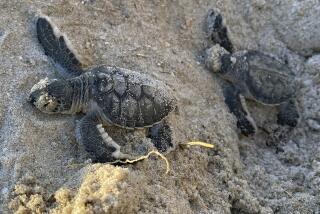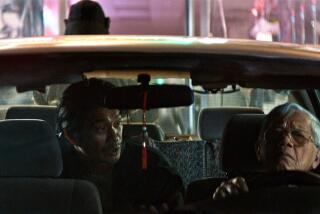On the Ground: Turtle is legendary in Vietnam, but it’s on the verge of extinction
- Share via
reporting from NGHIA SON, Vietnam — On a cool, calm morning, the waters of vast Dong Mo reservoir shimmered like green-gray cellophane.
In a gently paddled canoe, three employees of the Asian Turtle Program and a lone reporter glided forward. After a few silent minutes, the men aimed cameras and began speaking in soft but excited tones.
“You brought luck!” Pham Van Thong said, displaying on his digital camera the distant image of something disrupting the lake’s surface. (The reporter had missed it and felt unlucky.)
But they had no doubt: It was him, the only giant Yangtze soft-shell turtle known to remain in the wild — and one of only three Rafetus swinhoei known to exist anywhere. The others, an aged female and her apparently impotent male companion, reside in China’s Suzhou Zoo.
The rare species received a flurry of international attention in January as Vietnam mourned the death of Hanoi’s beloved 360-pound Cu Rua, or Great-Grandfather Turtle, about 30 miles from this village. For as long as anyone could remember, the reptile, well over 100 years old, had resided in small Hoan Kiem Lake and was revered as a link to Vietnam’s heroic mythology.
The course ahead for the species is unclear, given the centuries-old tension between Vietnam and China, now focused on disputed islands in the South China Sea.
“Twenty-odd years of searching have produced no others,” said naturalist Peter Pritchard, a leading turtle expert whose latest book was titled “Rafetus: The Curve of Extinction.” He professes optimism, however, that the Dong Mo turtle and the Chinese female have a chance to rebuild the population, much as a Galapagos species was brought back from the brink.
For the Vietnamese, the Dong Mo turtle is a reminder of the tale of 15th century emperor Le Loi: of how the heavens provided him with a magical sword to drive invaders back to China and how he then returned the weapon to a turtle in the lake. The place was renamed Hoan Kiem, or Lake of the Restored Sword.
Until the 1990s, the largest of Asia’s turtle species was not uncommon in the wetlands of major river systems of southern China and northern Vietnam. It’s possible, conservationists say, that the turtles thrived in Hoan Kiem long ago.
In the 1880s, the postcard-ready Turtle Tower shrine rose on a small island in the lake, offering a sunbathing spot for the turtles. Today, Vietnamese and tourists alike frequent a popular temple on the lake that exhibits the preserved remains of Cu Rua’s former companion — 6 feet long, 3 feet wide — which died in 1978. (Plans call for Cu Rua to be preserved and displayed at a national museum.)
Over the last generation, hunting and urbanization have all but wiped out the species, though hope endures that a few of the stealthy creatures may yet lurk in the marshes, mud and water.
Pham Xuan Tu, 60, is a one-armed farmer and fisherman who for decades has managed the Dong Mo fishery. He remembers when scores of the turtles destroyed nets and “ate my fish.” Decades ago, he explained, nobody cared that these “pests” were the same species as the Hoan Kiem turtles. Tu and a trapper caught as many of the big turtles as they could to sell as food and folk medicine, with many winding up in China.
Tu, who fought against the Chinese in the 1979 border clash, laughed when asked whether he lost his left forearm to warfare. It was a fishing accident, he explained, with faulty Russian explosives.
The Dong Mo reservoir is about 1,000 times the size of Hoan Kiem, which has raised hope that the reptile may not be as lonely as is commonly assumed. Nghia Son native Nguyen Van Trong, a former fisherman who works for the internationally funded turtle project, bases his optimism on his observations from a distance and sightings reported by others. His colleague Thong says that anecdotes, but no photographic evidence, have raised hope at two other locations in northern Vietnam.
Thong and colleague Hoang Van Ha, graduates of Vietnam’s forestry university, learned the legend as children. They became more familiar with Cu Rua in early 2011, when sightings of the turtle, once rare, became common as the aging, ailing reptile struggled for oxygen. Authorities worked to clean the polluted lake and nursed Cu Rua back to health.
Vietnamese culture is rich in superstition, and many citizens tried to divine meaning from the fact that Cu Rua succumbed on the eve of a vital Communist Party conference.
A close examination cleared up one mystery. A previous examination of the ailing Cu Rua in 2011 prompted one biologist to declare that Great-Grandfather was actually female. Determining the sex of a turtle is difficult, according to project director Tim McCormack, but now biologists agree that Cu Rua was male after all.
McCormack and Ha came into close contact with the leathery beast at Dong Mo on a memorable day in 2008 when a flood had damaged the dam and the turtle wound up in a rice paddy a few miles downstream.
The rice farmer who found the turtle, Ha recalled, turned down an offer of about $2,000 rather than run afoul of the law protecting endangered species. He accepted the turtle project’s modest compensation for the damage caused by the turtle. The priority, Ha recalled, was to return the specimen to its habitat as quickly and safely as possible.
Cu Rua’s demise inspired speculation that Vietnam’s leaders might attempt to move the Dong Mo turtle to Hoan Kiem for sentimental reasons. The much better course, conservationists say, would be to capture and transport him to China, but the politics are complicated. Hostility between Vietnam and China has intensified after Beijing initiated mineral exploration and construction of islands that both countries claim as sovereign territory.
Vietnamese conservationists express doubts that authorities would be willing to send Vietnam’s only known Rafetus to China. A better possibility, Ha suggests, would be to deliver his sperm to the Chinese zoo.
Tu, the one-armed fisherman, is now cooperating with efforts to save the species he once hunted. Between shots of home-brewed rice wine, Tu gave an unsentimental assessment of the Vietnamese legend and said that species’ peril is just a matter of nature taking its course.
The good news, Ha says, is that fishing with explosives is now illegal.
Harris is a special correspondent.
ALSO
Woody Allen says he’s done hiding behind comedy
Hyperloop One succeeds at first of many much-hyped tests
From coast to coast, middle-class communities are shrinking
More to Read
Sign up for Essential California
The most important California stories and recommendations in your inbox every morning.
You may occasionally receive promotional content from the Los Angeles Times.










